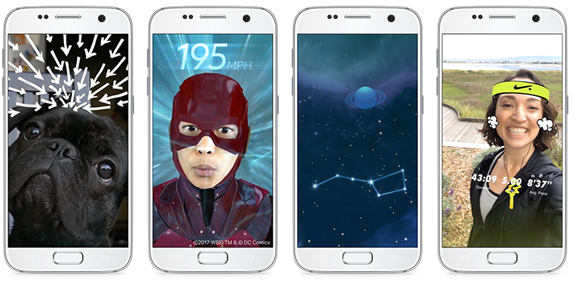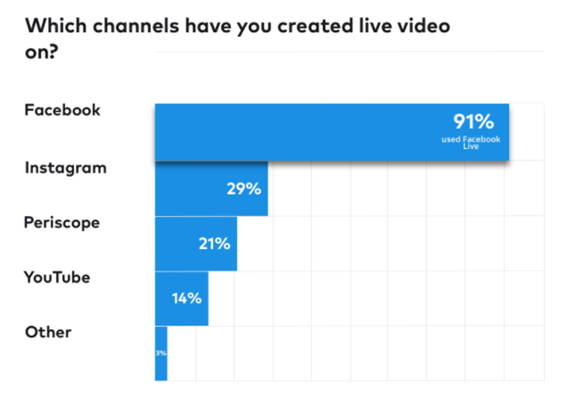The world of social media is always changing. Even within one given platform, the utilization shifts as new technology comes out and the attention of account users change along with it. For a business looking to exploit the benefits of social media, taking advantage of these trends is important. The earlier on a company identifies the social trends the easier it becomes to take advantage prior to the competition. For 2018, here are the current top social media trends to consider bringing into the fold of a company’s inbound marketing approach.
Ephemeral Content
This is a new term for something most businesses have, at the very least, heard of. It means short-lived content, designed to disappear after a short window. On the old Mission: Impossible TV show, an agent would receive a message designed to self-destruct in a few seconds. In other words, the agent needed to take everything from the content immediately, before it disappeared. In a marketing sense, this is what ephemeral content is.
Snapchat offers the most obvious reference to ephemeral content. Content posts to the social media platform disappear, usually after a 24-hour window. However, other social platforms have followed suit in recent years, with Instagram and Facebook providing “story” features, where an individual can post visuals, video and other content designed to disappear after a short amount of time.
Advertisers might wonder what the point is of creating short-lived marketing material, but it has a valuable place in a company’s viable outreach plan. For starters, it instantly appears at the top of any follower or subscriber’s display window.
There’s another perk with this as well. According to Sprout Social (2017), 46 percent of users who unsubscribed from a business channel did so because the brand posted too much. Over-posting clogs up the profile, taking their attention away from friends and family. By creating ephemeral content, it disappears after a short time, which prevents this from happening (while almost always remaining at the top of their display window).
(Source)
Other reasons why people unfollow a brand on social media? 41 percent say the posted content isn’t relevant, 35 percent say they Tweet too frequently, and 30 percent say the brand uses slang that doesn’t fit the brand.
Small Businesses are Growing With Social Media
It should come as no surprise that small businesses are turning to social media more now than ever before. Social media has the power to level the advertising playing field. Large corporations with a marketing budgeting fo millions of dollars no longer have a significant advantage. Yes, these companies still are able to pay for more advertising, but small businesses with a keen eye on social media trends can undercut larger corporations.
Large businesses move slowly. As a large machine, it takes more time for the machine to slow down and turn. Small businesses can turn on a dime and put forward additional resources and time into emerging social media trends while adapting its current social media presence to better fit the needs of a target audience.
(Source)
With more small businesses discovering this, it has helped these companies grow and prosper. There’s a reason why, according to Small Biz Trends (2018), 52 percent of all small businesses post to social media every single day.
Most of the content is directed to Facebook, with this platform receiving 86 percent of small businesses posting to this account every day. Next is Instagram at 48 percent, YouTube at 46 percent and Twitter at 44 percent.
For a small business to prosper, it’s crucial for it to connect with a target audience. As this target audience is located on a spectrum of social media platforms, the easiest way to connect is by spreading the wealth and posting to varying accounts.
User-Generated Content
One of the best forms of marketing is the content customers produce. With social media, it’s now possible for clients to tag businesses, let followers know what products they are using and how the products have affected his or her life. This material provides some of the best marketing potential possible.
In short, user-generated provides a company with free advertising. Similar to user reviews posted on a website, this material showcases a product and how it’s used in real life. It also saves a business money on marketing.
Growing a social presence isn’t just the drive of a business. Many users want to grow their own social presence. So when followers learn their quality posts may end up featured by a brand (and potentially increase their follows and subscribers), they are more likely to post favorable content to their profiles.
One of the best ways for a business to do this is by asking users to include a specific hashtag. This way, the company can easily sift through posts and share the best.
As Quicksprout (2017) points out, 73 percent of customers say user-generated content increases their purchase confidence, while 71 percent say it improves their belief of customer feedback. 65 percent say it’s far more interesting than the content a company produces, while 61 percent say they become more likely to engage with a brand.
(Source)
The Drop of Organic Reach
For anyone who has worked in search engine optimization and social media advertising for any amount of time, organic reach has long proven an important, fundamental step. While organic reach still has its place, it no longer holds the same level of importance as it once did. In fact, referral and organic reach are declining significantly in the world of social media.
When Facebook started to allow advertisements within the feed of social media profiles, businesses and advertisers saw the opportunity and flooded the platform. This inundated account holders with an over saturation of advertisements. In turn, this dramatically affected the impact of ads.
As advertisers saw drops in its ROI while ad bid prices continued to increase, companies started to leave Facebook, which is what brought about the most recent changes. Now, Facebook has changed its allotted marketing algorithm so organic reach now makes up less than 50 percent of displayed advertisements (according to Buffer Social, 2018).
As the graph indicates, external referral traffic made up around 41 percent of all traffic on Facebook in February of 2017. However, by the end of January 2018, this number shrank down to around 22 percent, slicing external referral traffic in half within a single year.
(Source)
This means advertising on Facebook has fundamentally changed. In order to reach the desired audience, it’s now necessary to rely on customers sharing links, providing helpful blog posts, going live on video and using maid influences in order to increase traffic.
Social Listening
There’s a reason why when mentioning a product within an IM on Facebook it appears in an advertisement not long after. If writing about a movie still in theaters, services like Fandango may pop up a ticket-buying option directly within the message.
There is no physical person sitting there, reading conversations. However, social media service providers can scan over messages sent and received instantly and search for specific keywords. When these keywords appear it tells the platform to bring up an advertisement.
Social listening opens up a world of possibilities. It makes it possible to know when customers are referring to a company or its specific products. By identifying what someone is saying a business can better formulate ways to market to these consumers.
There are a number of social listening methods out there. SproutSocial provides one such option, which includes a free trial.
(Source)
The more data a business has, the easier it becomes at customizing marketing material for its key demographic. While some may wave digital flags at the potential ethical reasoning behind sifting through someone’s conversation, it does bring up valuable advertising opportunity.
Influencer Marketing
A social influencer is someone with a large number of followers, either on one platform or a number of social platforms. These are individuals followed by specific demographics with an interest in video games, makeup, fashion, travel or another more streamlined target. This makes using a social influencer extremely beneficial in connecting with a target audience. In fact, according to Medium (2018), a social influencer has a 60 percent higher engagement than a celebrity influencer (such as a sports star or actor). On top of it all, influencer marketing is 6.7 times more cost efficient per engagement, making it an affordable form of marketing.
(Source)
Chatbots
There’s nothing new with an instant messenger chatbot. In fact, chatbots have been around since the days of AOL AIM. However, chatbots are far more engaging now with the technological improvements made over the years. Now, it’s possible for a chatbot to have an actual conversation with a customer.
The pizza chain Pizza Hut now allows users to order a pizza directly through the Facebook IM as if texting a store. Designed to understand phrases used within the conversation, a chatbot can provide a business with a helpful service while eliminating the need to pay for someone to sit on Facebook (and other social media platforms) in order to converse with customers. In fact, according to Juniper Research (2017), chatbots will save companies an estimated $8 billion annually by 2022.
AR (Augmented Reality)
Short for augmented reality, there’s a reason why social media platforms are beginning to buy up and expand with AR and VR (virtual reality) services.
The two, while similar in name, is different. Virtual reality places the user in a completely new world (such as flying a spaceship). Augmented reality, on the other hand, adds additional content to the physical world. The Pokemon Go mobile application made big waves in 2016 by allowing users to “hunt” for Pokemon creatures. When they’d end up at a location on their GPS map, they could open the application and, using the camera, see the creature appear on the mobile screen as if it were physically there.
In terms of social media applications, platforms such as Snapchat allow face filters, which distorts the face by adding in the augmented material (such as turning the head into a giant taco or adding in other effects).

(Source)
Augmented filters not only allow users to have fun altering their physical appearance, it also works for brand recognition. Companies ranging from Taco Bell to Gatorade have created AR filters for Snapchat. Popular filters can increase brand recognition as other subscribers see the filter and want to download on their own.
Other platforms have started to jump on in the world of AR. Facebook and Instagram (which Facebook owns) are now releasing new augmented reality features, designed to boost user interaction.
Paid Social Media Advertising
According to Facebook, six million advertisers are pushing products on the platform. Instagram is fast approaching these lofty numbers as well with two million monthly advertisers. With the ability to finely tune marketing material for a key demographic, this shouldn’t come as a big surprise. In fact, according to eMarketer (2016), social media marketing will surpass newspaper marketing by 2020.
While promoting content on social media through other means is still important, paid social media advertising can help significantly post exposure. According to the same eMarketer research, while digital ad spending has risen from 14.7 percent to 22.3 percent since 2014, ad revenue has increased from $7.32 billion to $19.3 billion
Live Video
Live video provides an abundance of potential. Plus, more and more social media platforms are now offering this kind of opportunity for companies.
Snapchat helped popularized the feature of small clips of live video. Twitter’s Periscope service has also revolutionized the ability to create live video subscribers can watch. It has become so popular other platforms such as Instagram and Facebook have started. The benefit of live video, other than allowing customers the ability to watch live content, is notifications for the live video go out to subscribers, and it appears at the top of a user’s profile window. This way, it’s instantly there for them to see and puts a business ahead of all other profiles out there.
According to Marketing Diva (2018), 95 percent of brand executives have said they plan on implementing live video into their marketing approach moving forward. According to the same research, nearly 60 percent of customers said it helps humanize the brand as well.
While Snapchat and Periscope helped create live video, Facebook is overwhelming the favorite, as 91 percent of business professionals turn to it for marketing. The next nearest accounts are Instagram with 29 percent and Periscope at 21 percent (Quicksprout, 2018).

(Source)
In Conclusion
These are the top 10 social media trends thus far in 2018. It’s possible some of these will evolve over the course of the year. However, from improved lived video services to utilizing user-generated content, a number of these trends are not likely to go away anytime soon. So, regardless of the business, how long it’s remained open or the products it sells, to fully harness the power of social media it is important to begin implementing these top social media trends into its inbound marketing approach.










